Mary Anne Yarde's Blog: The Coffee Pot Book Club , page 178
May 6, 2018
Life in the Time of Regency Engineer Officers By Jayne Davis #History #Regency #Romance @jaynedavis142
Life in the Time of Regency Engineer OfficersBy Jayne Davis
The heroes, and sometimes the villains, in regency romances are often involved in war, whether in the Royal Navy, the army, or as spies. Even if their wartime activities do not appear directly in the story, their military experiences shape their lives and their characters. In the army, the most glamourous were the cavalry or the Guards regiments, and this was reflected in the higher costs of purchasing commissions in those regiments than in regiments of foot.There were some army units in which commissions could not be bought—the engineers and the artillery. In both cases, cadets underwent the same basic training, including engineering (as you might expect!), chemistry and physics, and languages. On completion of basic training they could choose which branch to enter.The duties of an engineer officer were varied—I’ve described some of their responsibilities below using examples of construction, destruction, and transport, although each contains elements of the others. My examples are from the Peninsular War, mainly because there has been so much written about it, both as memoires and collected letters, and by later historians. The principles and general duties would have been similar in other parts of the world.ConstructionDue to the difficulties of campaigning in the winter, the Peninsular War involved a great many advances and retreats. After the disastrous retreat to Corunna in the winter of 1808-9, the British went back to Portugal to help to defend it against the French, under the command of Sir Arthur Wellesley. During that summer’s campaign the army got as far as Talavera, less than 80 miles from Madrid. They could not hold these positions, and Wellesley, now Viscount Wellington, retreated westwards. In October of 1809, he ordered the construction of a series of fortifications that became known as the Lines of Torres Vedras. Wellington provided guidance as to the areas to be surveyed and defended, but it was left to teams of engineers to carry out the surveying and determine the size and nature of the various fortifications, and then to supervise their construction.
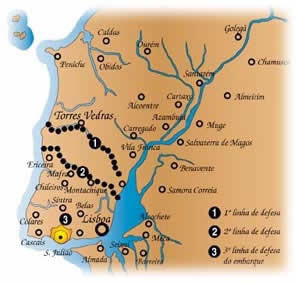 The Lines of Torres Vedras were built north of Lisbon.
The Lines of Torres Vedras were built north of Lisbon.
 One of the fortifications today.
One of the fortifications today.The fortifications achieved their purpose – the French armies could not penetrate them, keeping Lisbon and the British troops safe until they could venture forth again the following spring. DestructionThe conflicts in the Peninsular War included battles between opposing armies, such as at Talavera or Salamanca, and sieges of key fortress towns. The most notorious of the latter is the 3rd Siege of Badajoz, which many readers will have heard of because of the appalling atrocities carried out by the British troops after the fortress had been taken. As with all sieges, the basic plan was simple: fire artillery at the walls until part had crumbled enough for men to climb the pile of rubble, then send in the infantry. What I hadn’t realised before I read up about it a little more, was that before the artillery could even start firing, trenches had to be dug to protect the guns and the gunners.
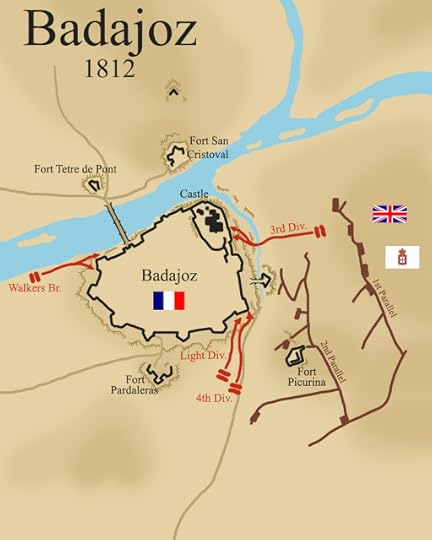 The brown lines show the length of the trenches dug during the 3rd Siege of Badajoz.
The brown lines show the length of the trenches dug during the 3rd Siege of Badajoz.Engineer officers were in charge of siting and constructing the trenches, and helping to decide where the guns were to be placed, but the actual digging was carried out—reluctantly—by normal troops.When the breaches in the walls were ‘practicable’, the engineers still had a role to play; one that could be as dangerous as being an infantry officer in the battalions attempting to scale the walls. The engineers knew their way through the trenches and where the weakest points in the walls were, and often led the attacking units. The engineering department also looked after scaling ladders used in secondary attacks and, again, would lead the infantry to the best places to attempt the walls.
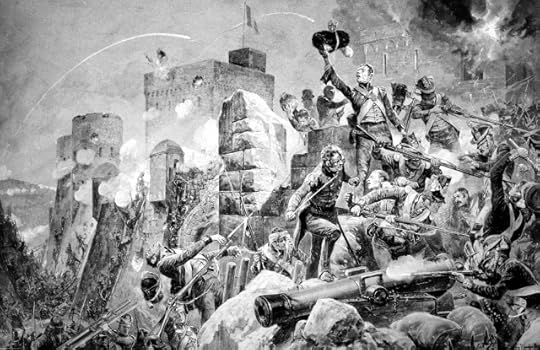 Storming the walls at Badajoz.The role of engineer officers in sieges was more hazardous than in their other areas of responsibility. I have a few books that are memoires, diaries or letters of officers in the Peninsular War. In this fairly random collection (bought in various second-hand bookshops), the two that concern engineers are both from young officers who died doing their duty: Edmund Mulcaster, killed during the artillery bombardment at Badajoz, and Lancelot Machell, killed while supervising men removing obstructions in the way of the attacking parties at the Siege of San Sebastian. Following a successful siege, the conquered town needed to be put back into a fit state to repel any enemy attempts to re-take it, and one or more engineers would be left with the new garrison to supervise repairs to the walls.TransportThe other activities that engineers were asked to undertake are possibly more interesting from the point of view of storytelling. Today, we are used to having detailed and accurate maps of anywhere we want to go. Not so then, and with thousands of men to move, as well as food, guns and ammunition, knowing which road to take, and whether it would be passable for wagons and the ox-teams pulling guns, was vital. This was particularly difficult in the mountainous regions of Spain, and later when Wellington’s army finally crossed the Pyrenees into France.Many engineers spent time riding ahead of the army scouting out suitable routes and mapping them, assessing bridges or the defences of nearby towns, or finding places where a temporary bridge could be put across a river. They could be sent with small working parties to prepare river crossings or repair bridges.During a retreat, the engineers would also be responsible for mining bridges, ready to blow them up before the following enemy army could cross. As Wellington’s armies spent several years advancing and retreating across Spain, it is quite likely that they were sometimes asked to rebuild bridges that their fellow engineers had demolished.
Storming the walls at Badajoz.The role of engineer officers in sieges was more hazardous than in their other areas of responsibility. I have a few books that are memoires, diaries or letters of officers in the Peninsular War. In this fairly random collection (bought in various second-hand bookshops), the two that concern engineers are both from young officers who died doing their duty: Edmund Mulcaster, killed during the artillery bombardment at Badajoz, and Lancelot Machell, killed while supervising men removing obstructions in the way of the attacking parties at the Siege of San Sebastian. Following a successful siege, the conquered town needed to be put back into a fit state to repel any enemy attempts to re-take it, and one or more engineers would be left with the new garrison to supervise repairs to the walls.TransportThe other activities that engineers were asked to undertake are possibly more interesting from the point of view of storytelling. Today, we are used to having detailed and accurate maps of anywhere we want to go. Not so then, and with thousands of men to move, as well as food, guns and ammunition, knowing which road to take, and whether it would be passable for wagons and the ox-teams pulling guns, was vital. This was particularly difficult in the mountainous regions of Spain, and later when Wellington’s army finally crossed the Pyrenees into France.Many engineers spent time riding ahead of the army scouting out suitable routes and mapping them, assessing bridges or the defences of nearby towns, or finding places where a temporary bridge could be put across a river. They could be sent with small working parties to prepare river crossings or repair bridges.During a retreat, the engineers would also be responsible for mining bridges, ready to blow them up before the following enemy army could cross. As Wellington’s armies spent several years advancing and retreating across Spain, it is quite likely that they were sometimes asked to rebuild bridges that their fellow engineers had demolished. 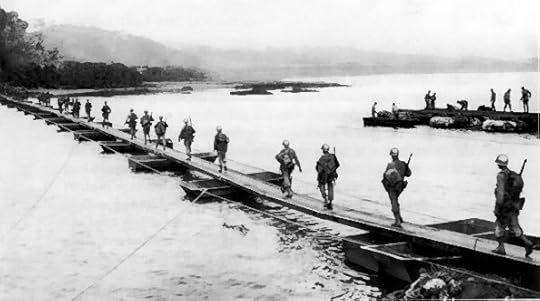 A pontoon bridge from WWII. Temporary bridges very similar to this were constructed by the engineers with Wellington’s army.
A pontoon bridge from WWII. Temporary bridges very similar to this were constructed by the engineers with Wellington’s army.All these activities give plenty of scope for contact with the enemy, spying, and other skulduggery and danger.The hero of my novel, The Mrs MacKinnons, was an engineer officer with the East India Company army and, although not described in detail in the book, his experiences there form the background to his part of the story.
References:
Much of the information for this article was taken from Wellington’s Engineers—Military Engineering in the Peninsular War 1808-1814, by Mark S. Thompson.The diaries referred to are:The Peninsular War Letters of Lancelot Machell, R.E. by Mark S. ThompsonThe Peninsular War Diary of Edmund Mulcaster, R.E. by Mark S. Thompson
All images are from Wikimedia CommonsMap of Torres Vedras: https://commons.wikimedia.org/wiki/File:Lines_of_Torres_Vedras.jpgPhoto of fortification: https://commons.wikimedia.org/wiki/File:Linhas_de_Torres_I.jpgMap of Badajoz: https://commons.wikimedia.org/wiki/File:Badajoz-battle.jpgStorming the walls: https://commons.wikimedia.org/wiki/File:Siege_of_Badajoz,_by_Richard_Caton_Woodville_Jr.jpgMachinato Inlet: https://commons.wikimedia.org/wiki/File:Crossing_of_Machinato_Inlet.jpg
Jayne DavisJayne Davis writes historical romances set in the late Georgian/Regency era, published as both ebooks and paperbacks.
She was hooked on Jane Austen and Georgette Heyer as a teenager, and longed to write similar novels herself. Real life intervened, and she had several careers, including as a non-fiction author under another name. That wasn't quitethe writing career she had in mind...
Finally, she got around to polishing up stories written for her own amusement in long winter evenings, and became the kind of author she’d dreamed of in her teens. Jayne loves to hear from readers, you can find her: Website Pinterest Twitter
The Mrs MacKinnons
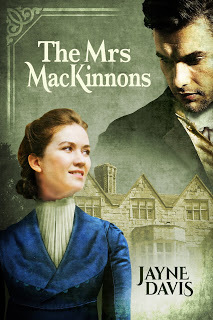 England, 1799Major Matthew Southam returns from India, hoping to put the trauma of war behind him and forget his past. Instead, he finds a derelict estate and a family who wish he'd died abroad.Charlotte MacKinnon married without love to avoid her father’s unpleasant choice of husband. Now a widow with a young son, she lives in a small Cotswold village with only the money she earns by her writing.Matthew is haunted by his past, and Charlotte is fearful of her father’s renewed meddling in her future. After a disastrous first meeting, can they help each other find happiness?
England, 1799Major Matthew Southam returns from India, hoping to put the trauma of war behind him and forget his past. Instead, he finds a derelict estate and a family who wish he'd died abroad.Charlotte MacKinnon married without love to avoid her father’s unpleasant choice of husband. Now a widow with a young son, she lives in a small Cotswold village with only the money she earns by her writing.Matthew is haunted by his past, and Charlotte is fearful of her father’s renewed meddling in her future. After a disastrous first meeting, can they help each other find happiness? 4.7* average on Amazon, available on Kindle Unlimited
Amazon
Published on May 06, 2018 23:00
May 3, 2018
For King, Country and Glory – Wellington’s Officers in the Peninsular War by Sharon Bennett Connolly #History #PeninsularWar @Thehistorybits
For King, Country and Glory – Wellington’s Officers in the Peninsular WarBy Sharon Bennett Connolly
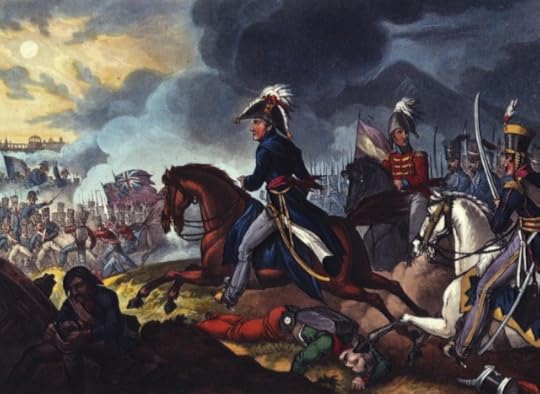
Sir Arthur Wellesley, 1st Duke of Wellington is attributed with saying that Waterloo was won on the playing fields of Eton (although he didn’t actually say it); however, the training ground for many of the officers who commanded at Waterloo was a much more hazardous school – and certainly had nothing to do with cricket.
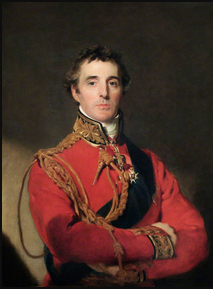 2015 marked the 200th anniversary of the Battle of Waterloo. The final battle in the Napoleonic Wars, Waterloo was the culmination of over 20 years of fighting. Wellington’s officers had earned their experience and reputation in Portugal and Spain, in the Peninsular War of 1807-1814, Napoleon Bonaparte’s ‘Spanish ulcer’.
2015 marked the 200th anniversary of the Battle of Waterloo. The final battle in the Napoleonic Wars, Waterloo was the culmination of over 20 years of fighting. Wellington’s officers had earned their experience and reputation in Portugal and Spain, in the Peninsular War of 1807-1814, Napoleon Bonaparte’s ‘Spanish ulcer’.Having risen through the ranks via the army system of purchase – where rank went to those who could buy it, rather than on merit – he was a colonel by the age of 27 and a major-general at 34. Many officers in the British army advanced this way and, although the system was flawed, it did give us the greatest British general of all time.
Practical and meticulous to detail in the day-to-day army administration, Wellington was determined his officers would train their men so they could beat any force they opposed.
He was a master of the battlefield.
Generally, the officers of the Peninsular War were the ‘stiff upper lip’ types. Their letters home spoke of action and adventure, but few officers spoke of their feelings in battle. These officers were gentlemen who desired glory and lived within a code of honour. Life in war, to them, was a grand experience and the battlefield was where glory could be achieved, if you survived it.
An officer’s life was generally better than that of the men. The officer’s had packs – or haversacks – containing rations (including a charge of rum) and spare equipment, but these were conveniently transported on carts, rather than their backs, like the common soldier.
Retreat, however, showed a less than honourable attitude of some of the officers. Some rode in carts while their men struggled to march – often barefoot. During the retreat to Corunna, in January 1809, there was an incidence of one officer climbing on the back of one of his men, so as not to get his feet wet while crossing a river. This proved a great morale booster for the men, when an even more senior officer ordered the soldier to drop his charge into the river.
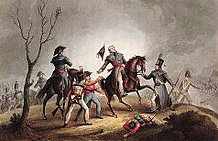 It was during retreat discipline was most likely to break down. The retreat to Corunna was harrowing for the men and officers; the Spanish winter was harsh and the French were constantly nipping at the army’s heels. Officers used a mixture of encouragement and punishment to cajole the men along. Punishment was harsh; floggings and hangings were inflicted for various crimes.
It was during retreat discipline was most likely to break down. The retreat to Corunna was harrowing for the men and officers; the Spanish winter was harsh and the French were constantly nipping at the army’s heels. Officers used a mixture of encouragement and punishment to cajole the men along. Punishment was harsh; floggings and hangings were inflicted for various crimes.The army’s discipline depended on the diligence of the regimental officers; men convicted of robber with violence or desertion were hanged, while looters and stragglers risked the lash. The chance of reprieve from punishment was dangled over regiments as a way of getting the men to fight harder when the enemy was close by.
Generals were loved, feared and admired in equal measure. ‘Black Bob’ Craufurd of the Light Brigade was seen as a harsh disciplinarian, but he looked after his men; he led them and suffered with them, marching in their midst and sharing in their miseries. General Roland Hill earned the nickname of ‘Daddy’ due to his care for his troops; his men adored him. And Sir John Moore, killed at the Battle of Corunna having brought the army safely through a harrowing retreat, was mourned deeply, his memory often invoked to encourage the men in the thick of battle.
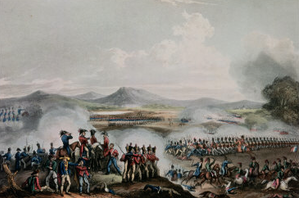 Officers were expected to be brave, to lead their men from the front, wherever possible. An officer was proud to fall injured in front of the regimental colours – leading their men, rather than following. They often waxed philosophical about the “beautifully romantic and heroically sublime”¹ battlefield, while describing the piteous moans of the wounded – men and horses – and the fury of the combatants. The chivalrous sense of honour was a code; one rode straight, spoke the truth and never showed fear.
Officers were expected to be brave, to lead their men from the front, wherever possible. An officer was proud to fall injured in front of the regimental colours – leading their men, rather than following. They often waxed philosophical about the “beautifully romantic and heroically sublime”¹ battlefield, while describing the piteous moans of the wounded – men and horses – and the fury of the combatants. The chivalrous sense of honour was a code; one rode straight, spoke the truth and never showed fear.Many officers considered themselves content and happy in the military life, thinking little about the enemy, except on the few occasions when they were brought to battle. Campaign life for an officer was a combination of adventure, enjoyment and discomfort; although they were expected to lead their men, they rarely kept company with them when not on the march. Officer and soldier were billeted separately wherever possible; the coarse behaviour of the men grated on the refined officer.
If they looked after their men, however, their men would look after them. There are numerous anecdotes of soldiers trying to protect their officers from the enemy, providing their officers with food and souvenirs taken from the enemy. According to Rifleman Harris, an act of kindness from an officer had often been the cause of his life being saved in the midst of battle.
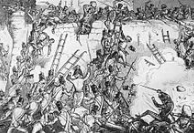 There were exceptions, of course. An area of Lisbon, known as Belem, was full of officers avoiding the fighting, who fell ill even when only within earshot of a battle. Wellington was happy for unsuitable officers to return home, or at least stay away from the army.
There were exceptions, of course. An area of Lisbon, known as Belem, was full of officers avoiding the fighting, who fell ill even when only within earshot of a battle. Wellington was happy for unsuitable officers to return home, or at least stay away from the army.Of those who remained, every officer was a volunteer; they saw the military life as a way of advancement in later civilian life – or as a way to be useful to their king and country. The majority were gentlemen; although their were rare instances of officers having risen from the ranks, these failed to gain the full respect of the common soldier and were not, as a rule, successful.
To many the army was a home. The military life was a profession, officers lived and died to “promote its honour and glory”².
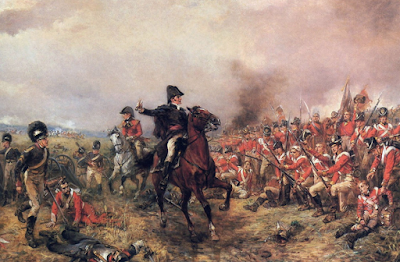 And Wellington was the heart of the army, his presence inspired confidence. Even with all his ambivalence of character, he exerted an extraordinary sense of loyalty among both officers and men. Sir John Kincaid said there was “not a bosom in the army that didn’t beat more lightly, when it heard the joyful news of his arrival.”³
And Wellington was the heart of the army, his presence inspired confidence. Even with all his ambivalence of character, he exerted an extraordinary sense of loyalty among both officers and men. Sir John Kincaid said there was “not a bosom in the army that didn’t beat more lightly, when it heard the joyful news of his arrival.”³And it was with the confidence and experience gained from 7 years of war in the Iberian Peninsular that Wellington led his army against the French for one last time. It would be the 1st time that Sir Arthur Wellesley, 1st Duke of Wellington, would face Napoleon Bonaparte, Emperor of the French; at Waterloo on 18th June 1815, 200 years ago.
References:First posted on History…The Interesting Bits 18/06/2015
Footnotes: ¹& ² A Boy in the Peninsular War, Robert Blakeney ; ³ Beggars in Red: The British Army 1789-1889, Sir John Kincaid, quoted by John Strawson.
Article adapted from my own dissertation of 1992, entitled For King, Country and Glory? The British Soldier in the Peninsular War, 1808-1814.
Pictures courtesy of Wikipedia
Sharon Bennett Connolly
 Sharon Bennett Connolly has been fascinated by history for over 30 years now. She has studied history academically and just for fun – and even worked as a tour guide at historical sites, including Conisbrough Castle.
Sharon Bennett Connolly has been fascinated by history for over 30 years now. She has studied history academically and just for fun – and even worked as a tour guide at historical sites, including Conisbrough Castle.Born in Yorkshire, she studied at University in Northampton before working in Customer Service roles at Disneyland in Paris and Eurostar in London.
She is now having great fun, passing on her love of the past to her son, hunting dragons through Medieval castles or exploring the hidden alcoves of Tudor Manor Houses.
On launching her own blog – History ... the Interesting Bits, Sharon started researching and writing about the lesser-known stories and people from European history, the stories that have always fascinated. Quite by accident, she started focusing on medieval women. And in 2016 she was given the opportunity to write her first non-fiction book, Heroines of the Medieval World, which has recently been published by Amberley. She is now working on her second book, Silk and the Sword: the Women of the Norman Coqnquest, which will be released in late 2018.
Sharon loves to hear from readers, you can find her: Website Facebook Twitter
Heroines of the Medieval World
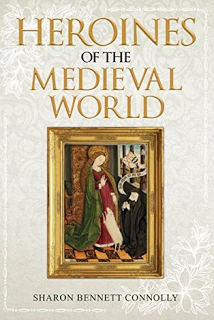 These are the stories of women, famous, infamous and unknown, who shaped the course of medieval history. The lives and actions of medieval women were restricted by the men who ruled the homes, countries and world they lived in. It was men who fought wars, made laws and dictated religious doctrine. It was men who were taught to read, trained to rule and expected to fight. Today, it is easy to think that all women from this era were downtrodden, retiring and obedient housewives, whose sole purpose was to give birth to children (preferably boys) and serve their husbands.Heroines of the Medieval World looks at the lives of the women who broke the mould: those who defied social norms and made their own future, consequently changing lives, society and even the course of history.
These are the stories of women, famous, infamous and unknown, who shaped the course of medieval history. The lives and actions of medieval women were restricted by the men who ruled the homes, countries and world they lived in. It was men who fought wars, made laws and dictated religious doctrine. It was men who were taught to read, trained to rule and expected to fight. Today, it is easy to think that all women from this era were downtrodden, retiring and obedient housewives, whose sole purpose was to give birth to children (preferably boys) and serve their husbands.Heroines of the Medieval World looks at the lives of the women who broke the mould: those who defied social norms and made their own future, consequently changing lives, society and even the course of history.Amazon US Amazon UK
Published on May 03, 2018 23:00
May 2, 2018
Author’s Inspiration ~ M.T. Magee #HistoricalFantasyRomance #MedievalFantasy #IrishLegends @Mtmagee1013M
Author’s Inspiration ~ M.T. Magee
“Fantasy is a necessary ingredient in living, it's a way of looking at life through the wrong end of a telescope, and that enables you to laugh at life's realities” Dr. Seuss

Imagine a world filled with epic adventure, breathtaking romance, where love of family, and the beauty of Celtic/Gaelic legend lives! Both books became award winning #1 International #Amazon #Bestsellers in the US UK CA AU FR BR Always #FREE with #KindleUnlimited
Creating an adventure, a love story that would leave you breathless, and a world like none imagined! That has been my motivation and my inspiration in becoming an historical fantasy author. To take you away to a world that will not only welcome you but hold you in its embrace until you must leave for a time. Only to welcome you back when the world becomes a bit hard to deal with. Escapism is it? It most certainly is, and I am proud to say I write it joyously and passionately, inviting you to leave behind your troubles, and cares for a time. The majesty of the Scottish Highlands and the ethereal beauty of Ireland come alive in the mythical realm of Rinefield!


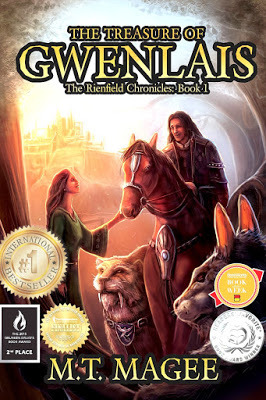 In the Treasure of Gwenlais you will find Princess Laurel of Gwenlais, is tragically and quickly thrust into a world of danger, so unlike the idyllic and sheltered life she has known. These dangers from an unknown enemy, also unexpectedly throw her into the arms of Caleb, the warrior Prince of Heathwin, the nearby Kingdom with whom Gwenlais has a tense alliance. The more refined people of Gwenlais, find their neighbors and protectors of the West necessary, but consider them uncouth and sometimes barbaric. The long and bloody feud between Heathwin, and the mysterious, frightening, and misunderstood, race of beings, called the Rabkins, had finally reached an uneasy truce, by the hard-fought and diligent efforts of Prince Caleb. This fragile agreement was soon shattered by an attack from outside; that threaten both Kingdoms of Gwenlais and Heathwin. Laurel and Caleb find themselves, not only fighting for the peace and existence of their Kingdoms but fighting for their newfound love that is imperiled at every turn from a nameless enemy, and their own people as well.
In the Treasure of Gwenlais you will find Princess Laurel of Gwenlais, is tragically and quickly thrust into a world of danger, so unlike the idyllic and sheltered life she has known. These dangers from an unknown enemy, also unexpectedly throw her into the arms of Caleb, the warrior Prince of Heathwin, the nearby Kingdom with whom Gwenlais has a tense alliance. The more refined people of Gwenlais, find their neighbors and protectors of the West necessary, but consider them uncouth and sometimes barbaric. The long and bloody feud between Heathwin, and the mysterious, frightening, and misunderstood, race of beings, called the Rabkins, had finally reached an uneasy truce, by the hard-fought and diligent efforts of Prince Caleb. This fragile agreement was soon shattered by an attack from outside; that threaten both Kingdoms of Gwenlais and Heathwin. Laurel and Caleb find themselves, not only fighting for the peace and existence of their Kingdoms but fighting for their newfound love that is imperiled at every turn from a nameless enemy, and their own people as well. In Child of the Kindred, book #2 in the continuing fantasy saga you will see the residents of Rienfield realizing their world is changing, and a new era has begun. Princess Laurel finds her kingdom of Gwenlais, torn and shattered from a bloody siege. Her people now looking to her to help them rise above the ruin and misery inflicted upon their once peaceful and sheltered realm. Laurel, and her beloved Prince Caleb, must find a way to unite their kingdoms as never before. The enemy from a distant land makes a bold and savage attempt to thwart the unity of the two kingdoms of Gwenlais and Heathwin. The odds have never been greater against the realms, or the two lovers that hold the kingdoms together. Will their people and their love survive all they have lost? Will new life rise from above the ruins?
In Child of the Kindred, book #2 in the continuing fantasy saga you will see the residents of Rienfield realizing their world is changing, and a new era has begun. Princess Laurel finds her kingdom of Gwenlais, torn and shattered from a bloody siege. Her people now looking to her to help them rise above the ruin and misery inflicted upon their once peaceful and sheltered realm. Laurel, and her beloved Prince Caleb, must find a way to unite their kingdoms as never before. The enemy from a distant land makes a bold and savage attempt to thwart the unity of the two kingdoms of Gwenlais and Heathwin. The odds have never been greater against the realms, or the two lovers that hold the kingdoms together. Will their people and their love survive all they have lost? Will new life rise from above the ruins? Join Laurel, Caleb, and an epic cast on an extraordinary journey, filled with excitement, treachery, danger and finding a love you only dared dream of! Come away mo chairde Rienfield is calling! Escape for a time and journey to a far away realm. A world where you will find the kingdoms of Gwenlais and Heathwin. A world filled with wonder, danger, adventure, romance, love of family as well as betrayal. The people, races, and beings will beckon you to return and visit, over and again, sharing in their joys, sorrows, tragedies and triumphs. Come away mo chairde! Rienfield is calling!

Amazon US Amazon UK
M.T. Magee
 My name is M.T.Magee I write bestselling YA Historical Medieval Fantasy that is beautifully romantic with whispers of Gaelic legend. On Mar. 31st The Treasure of Gwenlais received the 2015 Silver Medal Winner of Ireland's Drunken Druid Award Finalist for IAN Book of the Year Award 2016 for First Novel on Aug. 31st. On Sept.1st 2016 I received the Finalist Award for Readers' Favorite Book Awards Voted #1 On Listopia's Best Fantasy Romance (not urban).
My name is M.T.Magee I write bestselling YA Historical Medieval Fantasy that is beautifully romantic with whispers of Gaelic legend. On Mar. 31st The Treasure of Gwenlais received the 2015 Silver Medal Winner of Ireland's Drunken Druid Award Finalist for IAN Book of the Year Award 2016 for First Novel on Aug. 31st. On Sept.1st 2016 I received the Finalist Award for Readers' Favorite Book Awards Voted #1 On Listopia's Best Fantasy Romance (not urban).I live in New England on our small farm with my husband and son. We raise an assortment of silly goats, quiet rabbits, far too many ducks and chickens, and a high strung Border Collie cross named Gronk.
Published on May 02, 2018 23:00
May 1, 2018
Author Inspiration ~ Samantha Wilcoxson #HistoricalFiction #Tudor @carpe_librum
Author Inspiration By Samantha Wilcoxson
Inspiration for writing can come from the most unexpected and insignificant sources. Sunlight sparkling on waves might cause a scene to form in my mind, or a line in a book can send me running down virtual rabbit trails in search of information I had not realized I needed. Once I finished writing about Margaret Pole in Faithful Traitor, I was ready to be inspired toward a new historical figure in an earlier era. Then came the first tidbit of inspiration that I was not anticipating.A suggestion was made that I write about Princess Mary next. She was a girl, at first celebrated and pampered but later exiled and disowned, where I left her in Margaret’s story. Pole had been her governess, but I had not considered exploring Mary any further. More to prove that this recommendation was a poor one, I began some research.What I found was that I needed to write a novel about England’s first queen! Where Mary was mentioned, when she was mentioned at all, was as a secondary character, often a shadowy presence compared to her more glorious sister, Elizabeth. This could not be right. This was not the Mary I knew. How had no one else seen the side of her that her countrymen saw when they joyfully hailed her as their queen?
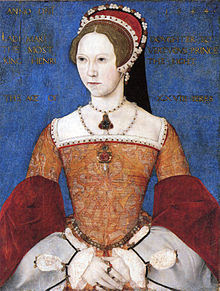 Mary I
Mary IThe same person who gave me the idea for writing about Mary gave me the exceptional idea of a title: Queen of Martyrs, and suddenly I had written a trilogy without ever meaning to. I never contemplated when I began Plantagenet Princess, Tudor Queen with a young Elizabeth of York in 1470 that I would eventually conclude the Plantagenet Embers series with her granddaughter Queen Mary’s death in 1558. And what tumultuous years they had been!Of course, Mary’s story continued to inspire me after it was written. My favorite secondary character of the entire trilogy has an important role in Mary’s life. Reginald Pole, Mary’s cousin, confidant, and Archbishop of Canterbury, simply begged to be written about. My study of him happened to coincide with the 500th anniversary of Martin Luther’s 95 Theses and a trip that included both Rome and Wittenberg. I was thoroughly captivated by the Reformation giants.
 Reginald Pole, Archbishop of Canterbury
Reginald Pole, Archbishop of Canterbury The more I read about Reginald Pole, the more I admire him. A Catholic Cardinal who strove to reconcile with Protestants at the Council of Trent. A cousin to the King of England who thwarted multiple assassination attempts. A friend to brilliant renaissance minds such as Michelangelo and Vittoria Colonna. Reginald Pole was a man in many ways ahead of his time. By this point, you will have guessed that my current project is a novella covering Reginald’s years before he travels to England in Queen of Martyrs.Life and history are filled with so many inspirational moments that I am certain to never write all the ideas that fly through my mind, but that is part of the joy of it. I look forward to seeing where it takes me next.
Samantha Wilcoxson
 Samantha Wilcoxson is an American writer with British roots. When she is not reading or travelling, she enjoys spending time at the lake with her husband and three teenagers.
Samantha Wilcoxson is an American writer with British roots. When she is not reading or travelling, she enjoys spending time at the lake with her husband and three teenagers.The Plantagenet Embers series debuted with 'Plantagenet Princess, Tudor Queen: The Story of Elizabeth of York'. It has been selected as an Editors' Choice by the Historical Novel Society and long-listed for the 2016 HNS Indie Award.
'Faithful Traitor: The Story of Margaret Pole' is the second novel in the trilogy, continuing the story of the Plantagenet remnant in Tudor times. This novel has received 5-stars from Readers' Favorite and a Discovering Diamond award.
The final installment in Plantagenet Embers, 'Queen of Martyrs', features Queen Mary I and her story of the counter-reformation in England.
Some of the secondary characters of the Plantagenet Embers series are explored in novellas, including 'The Last Lancastrian' featuring Margaret Beaufort and 'Once a Queen' which focuses on the final decade of Elizabeth Woodville's life.
Queen of Martyrs: The Story of Mary I(Plantagenet Embers Book 3)
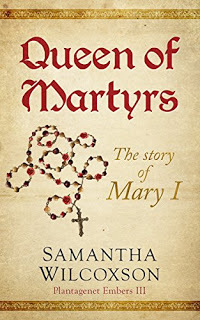 'God save the Queen! God save our good Queen Mary!'
'God save the Queen! God save our good Queen Mary!'When these words rang out over England, Mary Tudor thought her troubles were over. She could put her painful past - the loss of her mother and mistreatment at the hands of her father - behind her.
With her accession to the throne, Mary set out to restore Catholicism in England and find the love of a husband that she had long desired. But the tragedies in Mary's life were far from over. How did a gentle, pious woman become known as 'Bloody Mary'?
Amazon US Amazon UK
Published on May 01, 2018 23:00
April 30, 2018
Author’s Inspiration ~ G K Holloway #amwriting #HistoricalFiction #AngloSaxon @GlynnHolloway
My Inspiration by G K Holloway
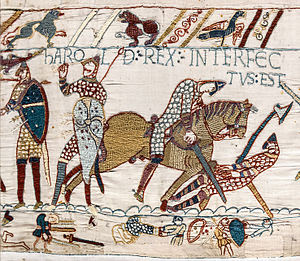
 The inspiration for writing my first novel came from a Christmas present given to me by my wife, Alice, who bought me a book by Ian W Walker called,
Harold, the LastAnglo Saxon King.
Keen as I am on history, I have to admit that at the time Alice gave me my present, I didn’t know a lot about 1066, the Battle of Hastings and the events that led up to the Norman Invasion. Walker’s book opened a door. Fascinated by what I’d read, I had a real hunger to know more, which led my to reading just about everything I could find on mid-eleventh century English history. The more I read, the more enthralled I became with the era. I’ve always been interested in history. As a boy, the view from my bedroom window was of a castle on a hill that dominated the landscaped for miles. It was the kind of view that would fire the imagination of any child. Naturally the questions followed, the anwers informed and the tales flowed. Eventually, I studied history and politics for my degree. Reading has also been an interest of mine, not since I was a kid - my dyslexia put paid to that - but I’ve alway liked stories in whatever medium they came. After all said and done, a story is a story. Film and TV were much easier for me but when I hit my teens I began to read novels for pleasure. And when I wasn’t reading? Talking – about books, or history or religion, in other words, stories. People used to tell me I ought to right a book, and I hope after they read my novel, they don’t change their minds. Looking back, I always wanted to produce a novel or a movie or anything really, so long as it was a story. After reading about Anglo-Saxon England and the Norman Invasion, I felt compelled to tell that particular story. I was like a junior reporter who had the most exciting scoop ever and wanted to tell the world the news – even if it was 950 years old! The reserach was an absolute joy; not just discovering the roles played by the major figures but more obscure things, like how the organ in Winchester Minster worked, how to make a sword, eleventh century power struggles – all of it – was a pleasure. So much so, the original novel was 297,000 words long and I hadn’t even finished. So, the Christmas present was the initial inspiration but day to day thoughts just fly into my head, rather like having a faulty radio sitting silently in the corner of a room that suddenly comes to life with a fragment of sentence or an idea for a scene or alarming news of a plot hole in my storyline. Music is another inspiration to me. I’m one of these people who find it so much easier to write with music playing. It doesn’t much matter what it is either. I’ve found instrumentals are best, which can mean anything from Miles Davis, Motzart, Philip Glass or movie soundtracks. Having said that, I’m also happy listening to Van Morrison, Bruce Springsteen, Mumford and Son. The songs don’t even have to be in English. I’ll play whatever I happen to be in the mood for and the music helps carry me to the place where the ideas come from. Once started it’s hard to stop, even though there are times when I find writing a bit of a grind I still have to plough on, knowing I will have one of those days when writing seems effortless, the ideas pour out of my head and my fingers are a blur over the keyboard. Yes, I can touch type, which is a useful skill to have when trying to keep up with all the ideas coming my way.
The inspiration for writing my first novel came from a Christmas present given to me by my wife, Alice, who bought me a book by Ian W Walker called,
Harold, the LastAnglo Saxon King.
Keen as I am on history, I have to admit that at the time Alice gave me my present, I didn’t know a lot about 1066, the Battle of Hastings and the events that led up to the Norman Invasion. Walker’s book opened a door. Fascinated by what I’d read, I had a real hunger to know more, which led my to reading just about everything I could find on mid-eleventh century English history. The more I read, the more enthralled I became with the era. I’ve always been interested in history. As a boy, the view from my bedroom window was of a castle on a hill that dominated the landscaped for miles. It was the kind of view that would fire the imagination of any child. Naturally the questions followed, the anwers informed and the tales flowed. Eventually, I studied history and politics for my degree. Reading has also been an interest of mine, not since I was a kid - my dyslexia put paid to that - but I’ve alway liked stories in whatever medium they came. After all said and done, a story is a story. Film and TV were much easier for me but when I hit my teens I began to read novels for pleasure. And when I wasn’t reading? Talking – about books, or history or religion, in other words, stories. People used to tell me I ought to right a book, and I hope after they read my novel, they don’t change their minds. Looking back, I always wanted to produce a novel or a movie or anything really, so long as it was a story. After reading about Anglo-Saxon England and the Norman Invasion, I felt compelled to tell that particular story. I was like a junior reporter who had the most exciting scoop ever and wanted to tell the world the news – even if it was 950 years old! The reserach was an absolute joy; not just discovering the roles played by the major figures but more obscure things, like how the organ in Winchester Minster worked, how to make a sword, eleventh century power struggles – all of it – was a pleasure. So much so, the original novel was 297,000 words long and I hadn’t even finished. So, the Christmas present was the initial inspiration but day to day thoughts just fly into my head, rather like having a faulty radio sitting silently in the corner of a room that suddenly comes to life with a fragment of sentence or an idea for a scene or alarming news of a plot hole in my storyline. Music is another inspiration to me. I’m one of these people who find it so much easier to write with music playing. It doesn’t much matter what it is either. I’ve found instrumentals are best, which can mean anything from Miles Davis, Motzart, Philip Glass or movie soundtracks. Having said that, I’m also happy listening to Van Morrison, Bruce Springsteen, Mumford and Son. The songs don’t even have to be in English. I’ll play whatever I happen to be in the mood for and the music helps carry me to the place where the ideas come from. Once started it’s hard to stop, even though there are times when I find writing a bit of a grind I still have to plough on, knowing I will have one of those days when writing seems effortless, the ideas pour out of my head and my fingers are a blur over the keyboard. Yes, I can touch type, which is a useful skill to have when trying to keep up with all the ideas coming my way. G K Holloway
 After graduating from Coventry University with an honours degree in history and politics, G K Holloway worked in education in and around Bristol, where he now lives with his wife and two children. After reading a biography about Harold Godwinson, he studied the late Anglo Saxon era in detail and visited all of the locations mentioned in the sources. When he had enough material to weave together facts and fiction he produced his novel. 1066 What Fates Impose, is the product of all that research – and some imagination. A sequel is on its way.
After graduating from Coventry University with an honours degree in history and politics, G K Holloway worked in education in and around Bristol, where he now lives with his wife and two children. After reading a biography about Harold Godwinson, he studied the late Anglo Saxon era in detail and visited all of the locations mentioned in the sources. When he had enough material to weave together facts and fiction he produced his novel. 1066 What Fates Impose, is the product of all that research – and some imagination. A sequel is on its way.1066 What Fates Impose
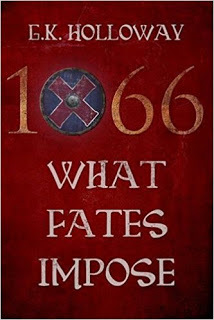 England is in crisis. King Edward has no heir and promises never to produce one. There are no obvious successors available to replace him, but quite a few claimants are eager to take the crown. While power struggles break out between the various factions at court, enemies abroad plot to make England their own. There are raids across the borders with Wales and Scotland. Harold Godwinson, Earl of Wessex, is seen by many as the one man who can bring stability to the kingdom. He has powerful friends and two women who love him, but he has enemies who will stop at nothing to gain power. As 1066 begins, England heads for an uncertain future. It seems even the heavens are against Harold. Intelligent and courageous, can Harold forge his own destiny - or does he have to bow to what fates impose?
England is in crisis. King Edward has no heir and promises never to produce one. There are no obvious successors available to replace him, but quite a few claimants are eager to take the crown. While power struggles break out between the various factions at court, enemies abroad plot to make England their own. There are raids across the borders with Wales and Scotland. Harold Godwinson, Earl of Wessex, is seen by many as the one man who can bring stability to the kingdom. He has powerful friends and two women who love him, but he has enemies who will stop at nothing to gain power. As 1066 begins, England heads for an uncertain future. It seems even the heavens are against Harold. Intelligent and courageous, can Harold forge his own destiny - or does he have to bow to what fates impose?Amazon UK Amazon US
Published on April 30, 2018 23:00
April 29, 2018
Life in the Time of…Lady Diana de Vere by Margaret Porter #History #17century @MargaretAuthor
 Margaret Porter is the author of A Pledge of Better Times and eleven more British-set historical novels for various publishers, including several bestsellers, award-winners, and many foreign language editions. She studied British history at universities in the U.K. and U.S., and afterwards worked in theatre, film and television.
Margaret Porter is the author of A Pledge of Better Times and eleven more British-set historical novels for various publishers, including several bestsellers, award-winners, and many foreign language editions. She studied British history at universities in the U.K. and U.S., and afterwards worked in theatre, film and television. Margaret loves to hear from readers, you can find her: Website Twitter Goodreads
A Pledge Of Better Times
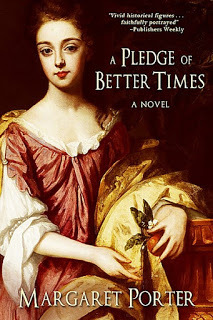 “Porter’s ambitious novel of 17th-century England is brimming with vivid historical figures and events . . . rigorously researched and faithfully portrayed.” ~ ~ Publishers Weekly“The remarkable figure of Lady Diana de Vere stands at the center of Margaret Porter’s sumptuous, wonderful new novel.” ~ ~ Historical Novels Review A sweeping tale of ambition, treachery, and passion incorporating 17th century historical figures, royalty, and events.For generations Lady Diana de Vere’s family loyally served England’s crown. But after King Charles II’s untimely death, her father firmly opposes James II’s tyranny. Charles Beauclerk, Duke of St. Albans—the late king’s bastard son by actress Nell Gwyn—also rebels against his newly crowned uncle’s manipulation.Political and religious turmoil bring revolution and yet another coronation before Charles returns to from war to claim his promised bride. As companion to Queen Mary Stuart, Diana has followed her de Vere forbears into royal service. She expects Charles to abandon his military career after marriage, but he proves unwilling to join the ranks of the courtiers he despises and mistrusts.In palace corridors and within their own household the young duke and duchess confront betrayals, scandals, and tragedies that threaten to divide them. And neither the privileges of birth nor proximity to the throne can ensure their security, their advancement—or their happiness.
“Porter’s ambitious novel of 17th-century England is brimming with vivid historical figures and events . . . rigorously researched and faithfully portrayed.” ~ ~ Publishers Weekly“The remarkable figure of Lady Diana de Vere stands at the center of Margaret Porter’s sumptuous, wonderful new novel.” ~ ~ Historical Novels Review A sweeping tale of ambition, treachery, and passion incorporating 17th century historical figures, royalty, and events.For generations Lady Diana de Vere’s family loyally served England’s crown. But after King Charles II’s untimely death, her father firmly opposes James II’s tyranny. Charles Beauclerk, Duke of St. Albans—the late king’s bastard son by actress Nell Gwyn—also rebels against his newly crowned uncle’s manipulation.Political and religious turmoil bring revolution and yet another coronation before Charles returns to from war to claim his promised bride. As companion to Queen Mary Stuart, Diana has followed her de Vere forbears into royal service. She expects Charles to abandon his military career after marriage, but he proves unwilling to join the ranks of the courtiers he despises and mistrusts.In palace corridors and within their own household the young duke and duchess confront betrayals, scandals, and tragedies that threaten to divide them. And neither the privileges of birth nor proximity to the throne can ensure their security, their advancement—or their happiness.Amazon UK Amazon US Kabo WaterstonesBarnes & Nobel
Published on April 29, 2018 23:00
April 26, 2018
Author’s Inspiration by Mark Wallace Maguire #amwriting #fantasy @WallaceMaguire
Author’s Inspiration by Mark Wallace Maguire
The thirst for escapism and the importance of fantasy

“You should really work on publishing that semi-autobiographical book you wrote, “The Preacher’s Son.” There is a lot of good stuff in there on religion, race, Southern Culture and fractured father-son relationships - real good dark stuff that could sell.”
I’ve heard that sentiment echoed the last couple of years in the wake of publishing The Alexandria Rising Chronicles. I did write said book, “The Preacher’s Son,” several years ago. And while it does have some strong story points, I am happy to leave it in my drawer dust-laden and undistributed for a long time, perhaps, forever, its 120,000 words quietly fading. Why?
While it was great therapy to write that book and saved me a ton of money on visits to a psychologist, it was painful and through time I realized that as painful it was for me to write it, it would be painful for someone to read. In other words, when I began my second attempt at writing a novel, I realized that I wanted to write something that I would want to read. A book for lack of a better word - fun.
A book with: • Ludlum-laced tension. • Tolkien-striving world creation. • Dan Brown pacing. • T.S. Eliot and Dante inspired symbolism. • Mysteries. Clues. Hints. Loss of truth. • Cold-blooded villains. Broken heroes. Mysterious maps.
I suppose it was that amalgamation in my conscious and subconscious of those elements that birthed, “The Alexandria Rising Chronicles.” Like many of us who read to escape, I have discovered the joy of escaping by writing.
You see, it is much more fun and healthier to slay a villain after verbally annihilating him, than it is to do so to a colleague or to someone who cuts you off in traffic.
There is also the fact that sometimes we all need to take a break from this reality. This world is not perfect. Everyone is fighting some type of battle. Those we love die. Those we expect so much from, let us down. We let others down. Bills pile up. The car breaks down. Injustice and hypocrisy are everywhere.
And then, there it is - the joy of escapism.
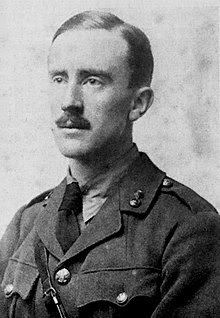 J.R.R. Tolkien
J.R.R. TolkienI often like to refer to J.R.R. Tolkien when I talk about this type of borderline apologetics for writing escapism. Tolkien went to World War I along with 17 of his classmates at Oxford.
Only two returned.
Two.
After surviving the gore of the Somme, he was quoted as saying:
“I have been a lover of fairy-stories since I learned to read,”
He later wrote in an essay in which he passionately defended fantasy and “escapist” fiction:
“Why should a man be scorned if, finding himself in prison, he tries to get out and go home? Or if, when he cannot do so, he thinks and talks about other topics than jailers and prison-walls?”
Here, here.
Mark Wallace Maguire
 Mark Wallace Maguire is the author of fictional series, The Alexandria Rising Chronicles, and Letters from Red Clay Country, a selection of his award winning columns and essays on South- ern Culture. His books have sold thousands of copies in more than ten countries. He has been named a Finalist for Independent Author of The Year and a Georgia Author of the Year nominee and his writing has drawn comparisons to Ian Fleming, John Grisham and Dan Brown.
Mark Wallace Maguire is the author of fictional series, The Alexandria Rising Chronicles, and Letters from Red Clay Country, a selection of his award winning columns and essays on South- ern Culture. His books have sold thousands of copies in more than ten countries. He has been named a Finalist for Independent Author of The Year and a Georgia Author of the Year nominee and his writing has drawn comparisons to Ian Fleming, John Grisham and Dan Brown. His work has also appeared in dozens of other publications including The Blue Mountain Re- view, The Essential C.S. Lewis and The Reach of Song. For nearly 20 years, Maguire worked for The Marietta Daily Journal and for 12 of those years as director of Cobb Life magazine and Cobb Business Journal where he earned more than 20 awards for his work from organizations such as The Associated Press and The Society of Pro- fessional Journalists. In 2005, he was named Berry College Outstanding Young Alumni of The Year.
Maguire lives in Fayetteville, Georgia with his wife and two sons and runs his own creative agency, MWM Communications, LLC. When he’s not busy writing or trying to corral his two boys, he enjoys hiking and playing guitar.
Alexandria Rising:Book #1 The Alexandria Rising Chronicles
 Rand O'Neal, an ambition-less newspaper reporter, is given a single task upon the death of his grandfather: Destroy a mysterious map. What should be a simple errand thrusts Rand into a journey across three countries chased by unknown pursuers where he discovers humanity's biggest secret. The novel has been reviewed as, "Superb," "Amazing" and "Extremely well written" and has drawn comparisons to Dan Brown, Ian Fleming and Robert Ludlum. The book is labelled an action adventure, but contains elements of conspiracy fiction, science fiction and suspense. It is also linked to a multi-media website which allows readers to engage with the experience in video, images and interactive appendices.
Rand O'Neal, an ambition-less newspaper reporter, is given a single task upon the death of his grandfather: Destroy a mysterious map. What should be a simple errand thrusts Rand into a journey across three countries chased by unknown pursuers where he discovers humanity's biggest secret. The novel has been reviewed as, "Superb," "Amazing" and "Extremely well written" and has drawn comparisons to Dan Brown, Ian Fleming and Robert Ludlum. The book is labelled an action adventure, but contains elements of conspiracy fiction, science fiction and suspense. It is also linked to a multi-media website which allows readers to engage with the experience in video, images and interactive appendices.Amazon

Published on April 26, 2018 23:00
April 25, 2018
Author’s Inspiration ~ Kerry A Waight #amwriting @Storiesofthen
Please give a warm welcome to newly published author, Kerry A Waight.
Author’s Inspiration
The Value of Community
 Writing is often a solitary task, be it for either pleasure or occupation. And, if you are like me, you don’t want to turn up for regular writing groups, where you sit around drinking coffee and discussing your work. Not that there is anything wrong with that—it just isn’t for me. But when I first retired and realised that I could finally start to write, I found that I needed some type of focus, support and direction.
Writing is often a solitary task, be it for either pleasure or occupation. And, if you are like me, you don’t want to turn up for regular writing groups, where you sit around drinking coffee and discussing your work. Not that there is anything wrong with that—it just isn’t for me. But when I first retired and realised that I could finally start to write, I found that I needed some type of focus, support and direction.So, I did what everyone does these days—I hit Facebook. Luckily for me, the first group I found was Authors’ Tale. This group has, without doubt, been the making of me as a published author. Let me explain.
During a phase when I wanted to be a professional genealogist (which I did do for a while), I undertook a couple of courses with the Society of Australian Genealogists. As part of the Diploma in Family Historical Studies, I was required to undertake a 32,000-word thesis. I chose one of my ancestral families as my subject. During my research, I uncovered some twists and turns that I thought would make good fodder for a fiction—the idea for my first novel was born.
Upon retirement, I found that now that I had the time, I could get started. And I started. But how did I know it was any good? Was my grammar okay? What about my tense? And, if I managed to finish it—what next? Hence my search and discovery.
Now Authors’ Tale has an activity every Wednesday called ‘Writing Prompt Wednesday’, where the group is given a prompt and whoever wants to can write something and submit it on the page. Took me a long time to gain the courage to do that. So much time that I didn’t have the confidence to submit anything to their first anthology Once Upon a Wednesday that was published in March 2017. I was determined, however, that I was going to submit for the next one.
I still didn’t have the courage to submit anything to the Facebook page except some comments on the posts of others, ask a few questions, and of course the mandatory ‘like’ and ‘love’ emoji. And I quietly worked away on my novel, but not very methodically. Then the date for submission came out for the second anthology, which would be entitled Heart of a Child. It was time. I found the list of past prompts and found one that would interest historical fiction me. The prompt was ‘a father having trouble telling his children a bedtime story’. It took me a while to work out how I was going to do that and then it hit me—it’s pretty hard to tell a bedtime story when you are dying of plague! One of my favourite topics so I knew I would be happy to do the research involved. That story is entitled ‘Tell us a story, Pa.”
Once that was done, I still had time. Okay I thought. Write another one. Luckily for me, there was a prompt where we had to write a story with a song as inspiration. I had already started one of those, so I dragged it back out. The song I was using was The Parting Glass, which evidence suggests had its beginnings in 1600. It has been attributed to the Scottish Thomas Armstrong, written in a letter before his execution for the murder of Sir John Carmichael. But the letter has morphed since then, with differing versions of it being sung today. It has also become very dear to the Irish. Being of Irish Catholic heritage (like many Australians), I decided to find a period in time where the version I wanted to write would make sense. Hours of research later, I discovered the Eleven Years War, which ran from 1641 to 1653 in Ireland. Perfect timing for a rewrite of the original from Thomas Armstrong! And that story became ‘Goodnight—and God be with you all.”
Before I had time to change my mind, I submitted both. I had gone from no-one reading my work to it going into a workshop where eight people would be critiquing it, followed by a judgement process by a panel. My heart was in my mouth. The workshop started, with varying degrees of suggestions and feedback coming. Even the ones with lots and lots of issues with my stories said that they were great stories. So, I made changes where I saw fit—although sometimes I decided that I would stick with what I had. But, interestingly, I found myself gaining confidence in my own work and judgement. Long story short—both stories made it into the anthology. I was so overwhelmed I cried. I could write, and I was going to be published.
Heart of a Child was published on 24th March 2018 and is available on Amazon. All profits from the sale will be going to a charity called Children of the Nations. Not only are my two stories in it, but eighteen other wonderful stories from some wonderful authors. We all supported each other. Importantly, we were honest with each other. Not everyone got stories in who submitted. But the feedback was constructive and valuable, and the final product maintained its integrity, which is important for every author involved.
I now have the confidence to proceed with my novel. I’m nearly finished (I think) and have begun editing. But it will be read by others in Authors’ Tale before it even goes for professional editing. I trust these guys. And, were it not for them, my novel would probably still be in the thought process phase.
Kerry A Waight
 A lover of history and genealogy, my intention to bring the story of people from the past to life through my writing. History is more than just dates and places. It is a web of the lives of the people from those dates and places, the consequences of decisions made and events that occur around them. I have a Bachelor of Arts, with History as my major subject, closely followed by Sociology/Anthropology. This was backed up with a Graduate Diploma in Secondary Education (Human Society in its Environment), plus a Certificate in Genealogical Research and a Diploma in Family Historical Studies.
A lover of history and genealogy, my intention to bring the story of people from the past to life through my writing. History is more than just dates and places. It is a web of the lives of the people from those dates and places, the consequences of decisions made and events that occur around them. I have a Bachelor of Arts, with History as my major subject, closely followed by Sociology/Anthropology. This was backed up with a Graduate Diploma in Secondary Education (Human Society in its Environment), plus a Certificate in Genealogical Research and a Diploma in Family Historical Studies. Having decided to retire early, I am involved with an animal rescue group called Peggy’s Promise: Helping Fur Kids with the Basics, as well as singing in a choir and writing. Married with two grown sons and a dog called Bindi, I find myself so busy now I don’t know how I managed to fit work in!
Kerry loves to hear from readers, you can find her: Website Twitter
Heart of a Child
 Whether you want to take a trip through time, go on an adventure in your backyard, or feel a burst of excitement only to return to an adult reality, each story has something for every reader who wants to feel like a child or be part of a life many children have led before.
Whether you want to take a trip through time, go on an adventure in your backyard, or feel a burst of excitement only to return to an adult reality, each story has something for every reader who wants to feel like a child or be part of a life many children have led before.Take a trip down memory lane or pull your child into your lap and see the world through their eyes. In this second anthology written by members of Authors’ Tale, both light and heavy themes bring out the child in almost every genre.
This year’s anthology features many stories about young hearts and for young-at-hearts. These tales will make any reader feel nostalgic or even open their eyes to something they never considered—something that will challenge their view of what childhood can really be like.
Amazon US Amazon UK Amazon AU
Published on April 25, 2018 23:00
April 24, 2018
Author’s Inspiration ~ Mary Jean Adams #History #HistoricalFiction @Maryjeanadams
Mary Jean Adams
 I read my first romance novel in seventh grade, and I've been hooked ever since. While other kids struggled to figure out what to write in their English journals, I tried my hand at a soap opera. I can still remember the "inappropriate" my English teacher wrote across the top of the page in red ink. Trust me, my seventh-grade imaginings were nothing like the romance novels of today!
I read my first romance novel in seventh grade, and I've been hooked ever since. While other kids struggled to figure out what to write in their English journals, I tried my hand at a soap opera. I can still remember the "inappropriate" my English teacher wrote across the top of the page in red ink. Trust me, my seventh-grade imaginings were nothing like the romance novels of today!I like to think my novels harken back to the traditional historicals of the 70s and 80s, but without some of the less appealing baggage, e.g., annoyingly all-too-perfect heroines. My heroes are strong, but with a softer side that they aren't afraid to share. My heroines are determined women with a mind of their own. I hope you enjoy reading about their lives as much as I enjoy bringing them to you.
Today, I live in Fargo, North Dakota with my husband, two kids, two cats and a tank full of ugly fish. (They’re ugly but they’re peaceful. I have enough conflict in my life, and I don’t need to watch fish constantly trying to kill each other.) To answer the main question everyone wants to know – No, Fargo is not like the movie. That was actually set in Minnesota. They just called it Fargo because it sounds cooler. Nevertheless, in the twenty years I’ve lived here, I have learned to say “Uf ‘da” and “You betcha” like a native, so maybe, just maybe, the movie has some resemblance to reality even if no one has stuck their spouse in a wood chipper. That I know of.
Le Chevalier
 Alexandra Turner lives in a world turned upside down. The British are preparing to invade Philadelphia. Her parents are dead from smallpox. Her twin brother, Reid, is more interested in the revolution than he is in his sister.
Alexandra Turner lives in a world turned upside down. The British are preparing to invade Philadelphia. Her parents are dead from smallpox. Her twin brother, Reid, is more interested in the revolution than he is in his sister.When the Chevalier de Mont Trignon enters her life, she has no reason to trust the mysterious foreigner. She is drawn to him even as she realizes how little she knows about the elegant yet enigmatic man. Can she trust him with her life? Can she trust him with her heart?
The Chevalier de Mont Trignon, in the service of the King of France, has sailed to America to gauge the Americans' chance for freedom for himself -- and to escape the boredom of the Parisian Court. Enthusiasm for the American cause reignites his passions, as does Alex Turner, a beautiful tavern owner determined to discover his true identity. Keeping her near him and keeping her safe while keeping her curiosity at bay is the truest test of his skills as a chevalier.
In the dangerous world of revolutionary America, where people aren't always who they seem to be, will the chevalier be Alex's salvation or her ruin?
Amazon US Amazon UK
Published on April 24, 2018 23:00
April 23, 2018
Life in the time of the Moors by Joan Fallon #History #Spain @joan_fallon
Life in the time of the Moors by Joan Fallon
My novel The Shining City is set in the middle of the 10th century, in southern Spain. In this blog, I’m going to explore what daily life was like for Fatima, the wife of the artisan, Qasim and the mother of three sons and two daughters.
The site for Madinat al-Zahra had been chosen by the caliph for a number of reasons, one of which was the abundance of water that flowed down from the neighbouring mountains, the Sierra Moreno. This water was collected in a reservoir and brought into the new city through a series of conduits and then piped to each house. There was always ample water on hand for washing, cooking and irrigation; even enough to have a small fountain on the patio. The city also had an elaborate drainage system for rainwater and sewage and Fatima’s house had its own latrine, which connected directly to it.
 Sierra Moreno
Sierra MorenoThe availability of water was important to Fatima and her family because cleanliness was a crucial part of the Muslim religion. Each time they prayed—and that was five times a day—they were required to wash first.
Fatima and her husband slept on bedrolls on the floor of their bedroom, and sometimes when the weather was very hot, they slept on the patio, or up on the roof. Her husband, Qasim always rose at cockcrow. She would fill the bucket with clean water so that he could wash, then he would dress and take his prayer mat out on the patio and pray. Once he’d made sure that all the family were awake and had said their prayers, Fatima would serve them breakfast —fresh goat’s milk from the goat tethered on one of the patios, and bread and honey, or sometimes in the winter, piping hot churros.
She always cooked outside on a small stove, fuelled by oil or wood and each day she went to the market to buy produce. Peasants would come in from the surrounding countryside and bring fruit and vegetables, which they would spread out for sale on mats in front of them. This was where she would buy the spices she needed to cook the tasty tagine that was her husband’s favourite dish and buy the chopped pieces of lamb, which she carried home wrapped in a vine leaf. At least once a week she would buy sticks of sugar cane, and occasionally some sugared almonds or some candied fruit as a treat. Before she moved into the city, she had lived in the countryside with her parents and there they grew their own fruit and vegetables and picked the almonds straight from the trees. She missed that.
If Fatima had time to spare, she would wander around the market, looking at the slaves for sale—some blond-haired and blue-eyed from the north and others, black as night, from Africa—and at the cooking pots, leather tablecloths, plates and bowls, colourful bales of cloth, slippers and much more. Sometimes she would stop on her way home and watch a procession of visiting ambassadors on their way to see the caliph, the paved road leading to the palace covered in rush matting and lined with soldiers. Hundreds of the caliph’s guards would lead the way, followed by a troupe of dancing girls, their bells and beads jangling all the while. Then would come the ambassadors, or sometimes a king from a far-off country. It was all so exotic and beautiful.
Then, last of all, she would make her way back to the baker, to collect her freshly baked bread —Fatima didn’t have an oven to cook her own bread so each morning she took the bread dough she had made the previous night, round to the baker to bake for her.
All of Fatima’s children had been educated—her husband was very keen on education, even for the girls—but only one was at school now, the youngest daughter. She was the clever one in the family and she wanted to become a doctor. It wasn’t unusual. There were lots of female doctors in the city, and lawyers and scribes. She was pleased that her youngest child had such high aspirations and her husband agreed with her. He would have liked his younger son to have studied more, but he was happy to work alongside his father and live at home.
Once a week Fatima and her youngest daughter would go to the public baths. There were two days a week when the hamman was open for women and she looked forward to it. It was not just the opportunity to bathe in hot water, but a chance to sit and chat to her friends. She would always have a massage and wash her hair. Sometimes the hairdresser would cut her hair for her and give her a manicure, but what she enjoyed most was the deep pool at the end of the session where she could lie in the water and soak until all her aches and pains disappeared.
Fatima took great care with her appearance. She wore a plain robe over her tunic and although she always wore a scarf around her shoulders, she rarely veiled her face—few women did in al-Andalus— and her head was uncovered, except for a close-fitting cap.
By and large, Fatima was happy with her life. Sometimes she missed living in the countryside but after so many years of marriage, she had become content with city life and there were so many more opportunities for her children there. If only her sons would get married and provide her with more grandchildren, then her life would be complete.
Joan Fallon
 Joan Fallon was born in Dumfries, in Scotland, the only child of a Scottish mother and an Irish father, but spent most of her formative life in the south of England. She left school at sixteen, instantly regretted it and spent the next fifteen years catching up on her education. She earned her teaching certificate and became a primary school teacher in Marlow, Buckinghamshire, but continued with her studies at the Open University, then a fairly new institution. Despite having a full time job, a husband and two young children she obtained an honours degree in History and Literature.
Joan Fallon was born in Dumfries, in Scotland, the only child of a Scottish mother and an Irish father, but spent most of her formative life in the south of England. She left school at sixteen, instantly regretted it and spent the next fifteen years catching up on her education. She earned her teaching certificate and became a primary school teacher in Marlow, Buckinghamshire, but continued with her studies at the Open University, then a fairly new institution. Despite having a full time job, a husband and two young children she obtained an honours degree in History and Literature.The sudden death of her son, when he was only seventeen, prompted her to make a career change and she took a post-graduate diploma in Management Studies. For a number of years she worked for Missenden Abbey Management Centre (then part of Brunel University) as Principal Lecturer in Leadership and Behavioural Studies, before successfully launching her own management and development company. Among her clients were the Foreign Office and the Environment Agency.
She then decided to settle in Spain, where she completed an Open University course in Creative Writing and began to devote herself to writing fiction.
If she had to name a writer who had influenced her work she would be hard pressed to answer - her reading taste is eclectic and ranges from Turgenev and Stendhal to William Boyd and Hilary Mantel. A natural storyteller, her novels, almost invariably, centre on a strong female character and explore the emotions and relationships of her protagonist. Many of her books are set in periods of recent history, such as the Spanish Civil War and the Second World War, and are meticulously researched.
Palette of Secrets, a contemporary story about an elderly woman who is haunted by her mysterious past has been published by S&H Publishing Inc in Virginia.
Joan has also written “Daughters of Spain”, a non-fiction book based on authentic interviews with a number of Spanish women of all ages and from all walks of life; this was first published by in 2009 and a revised edition came out in 2014.
Joan now lives in the south of Spain with her husband, where she has become passionate about both the language and history of her adopted home. This passion is reflected in the books she writes. She also has a web site dedicated to all things Spanish www.notesonspain.com
The Shining City
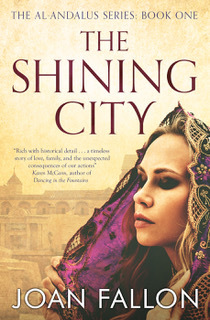 This is the story of a city, a city that is now in ruins: Madinat al Zahra. The year is 947 AD, a time when southern Spain is under the rule of the Moors. The ruler, Caliph al Rahman III is rich, powerful and cultured. His lands are, at long last, at peace and the capital, Córdoba, is considered to be not only the most beautiful city in the civilised world but also the seat of learning and culture. Against this background we meet the artisan Qasim - he and his family have moved to Madinat al Zahra to make their fortune as potters.
This is the story of a city, a city that is now in ruins: Madinat al Zahra. The year is 947 AD, a time when southern Spain is under the rule of the Moors. The ruler, Caliph al Rahman III is rich, powerful and cultured. His lands are, at long last, at peace and the capital, Córdoba, is considered to be not only the most beautiful city in the civilised world but also the seat of learning and culture. Against this background we meet the artisan Qasim - he and his family have moved to Madinat al Zahra to make their fortune as potters. Qasim is a good husband and father. He works hard, says his prayers and keeps out of trouble. But Qasim has a secret; his past is not what it seems. When a stranger arrives asking questions about him, he is worried that his secret will be discovered and everything he has worked for will be destroyed. He has to take action.
The Shining City is a BRAG Medallion honouree.
Amazon
<!-- /* Font Definitions */ @font-face {font-family:"Cambria Math"; panose-1:2 4 5 3 5 4 6 3 2 4; mso-font-charset:0; mso-generic-font-family:auto; mso-font-pitch:variable; mso-font-signature:-536870145 1107305727 0 0 415 0;} @font-face {font-family:"Arial Unicode MS"; panose-1:2 11 6 4 2 2 2 2 2 4; mso-font-charset:0; mso-generic-font-family:auto; mso-font-pitch:variable; mso-font-signature:-134238209 -371195905 63 0 4129279 0;} @font-face {font-family:"Helvetica Neue"; panose-1:2 0 5 3 0 0 0 2 0 4; mso-font-charset:0; mso-generic-font-family:auto; mso-font-pitch:variable; mso-font-signature:-452984065 1342208475 16 0 1 0;} /* Style Definitions */ p.MsoNormal, li.MsoNormal, div.MsoNormal {mso-style-unhide:no; mso-style-parent:""; margin:0cm; margin-bottom:.0001pt; mso-pagination:widow-orphan; font-size:12.0pt; font-family:"Times New Roman"; mso-fareast-font-family:"Arial Unicode MS"; border:none; mso-ansi-language:EN-US;} a:link, span.MsoHyperlink {mso-style-noshow:yes; mso-style-priority:99; mso-style-qformat:yes; color:blue; mso-themecolor:hyperlink; text-decoration:underline; text-underline:single;} a:visited, span.MsoHyperlinkFollowed {mso-style-noshow:yes; mso-style-priority:99; color:fuchsia; mso-themecolor:followedhyperlink; text-decoration:underline; text-underline:single;} p.HeaderFooter, li.HeaderFooter, div.HeaderFooter {mso-style-name:"Header & Footer"; mso-style-unhide:no; mso-style-parent:""; margin:0cm; margin-bottom:.0001pt; mso-pagination:widow-orphan; tab-stops:right 451.0pt; font-size:12.0pt; font-family:"Helvetica Neue"; mso-fareast-font-family:"Arial Unicode MS"; mso-bidi-font-family:"Arial Unicode MS"; color:black; border:none;} p.Body, li.Body, div.Body {mso-style-name:Body; mso-style-unhide:no; mso-style-parent:""; margin:0cm; margin-bottom:.0001pt; mso-pagination:widow-orphan; font-size:11.0pt; font-family:"Helvetica Neue"; mso-fareast-font-family:"Arial Unicode MS"; mso-bidi-font-family:"Arial Unicode MS"; color:black; border:none; mso-ansi-language:EN-US;} span.Hyperlink0 {mso-style-name:"Hyperlink\.0"; mso-style-unhide:no; mso-style-parent:Hyperlink; color:blue; mso-themecolor:hyperlink; text-decoration:underline; text-underline:single;} .MsoChpDefault {mso-style-type:export-only; mso-default-props:yes; font-size:10.0pt; mso-ansi-font-size:10.0pt; mso-bidi-font-size:10.0pt; mso-fareast-font-family:"Arial Unicode MS"; border:none;} .MsoPapDefault {mso-style-type:export-only;} @page WordSection1 {size:595.3pt 841.9pt; margin:2.0cm 2.0cm 2.0cm 2.0cm; mso-header-margin:35.45pt; mso-footer-margin:42.5pt; mso-paper-source:0;} div.WordSection1 {page:WordSection1;} </style> -->
Published on April 23, 2018 23:00
The Coffee Pot Book Club
The Coffee Pot Book Club (formally Myths, Legends, Books, and Coffee Pots) was founded in 2015. Our goal was to create a platform that would help Historical Fiction, Historical Romance and Historical
The Coffee Pot Book Club (formally Myths, Legends, Books, and Coffee Pots) was founded in 2015. Our goal was to create a platform that would help Historical Fiction, Historical Romance and Historical Fantasy authors promote their books and find that sometimes elusive audience. The Coffee Pot Book Club soon became the place for readers to meet new authors (both traditionally published and independently) and discover their fabulous books.
...more
...more
- Mary Anne Yarde's profile
- 159 followers



